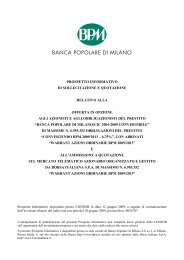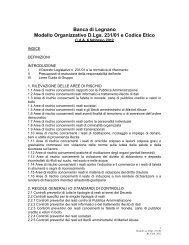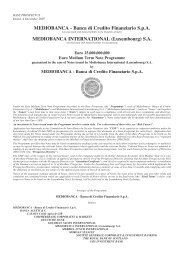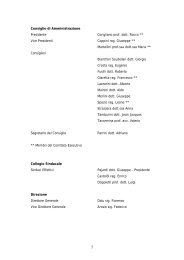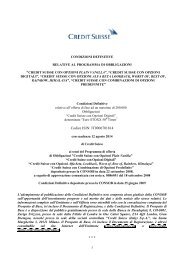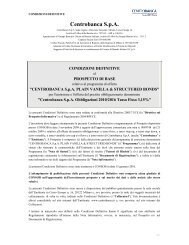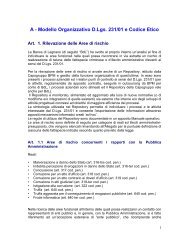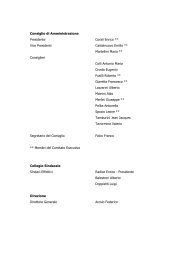INDEX OF DEFINED TERMS - Banca di Legnano
INDEX OF DEFINED TERMS - Banca di Legnano
INDEX OF DEFINED TERMS - Banca di Legnano
Create successful ePaper yourself
Turn your PDF publications into a flip-book with our unique Google optimized e-Paper software.
Level: 2 – From: 2 – Wednesday, July 21, 2010 – 11:55 – eprint6 – 4247 Section 02<br />
Risk Factors<br />
those of the U.S. Federal Reserve Board and non-U.S. central banks, have profound effects<br />
on interest and exchange rates which, in turn, affect prices of derivative instruments. Many<br />
other unforeseeable events, inclu<strong>di</strong>ng actions by various government agencies and domestic<br />
and international political events, may cause sharp market fluctuations.<br />
• Risks of short selling: A fund may sell securities short. Short selling exposes a fund to<br />
theoretically unlimited risk due to the lack of an upper limit on the price to which a security<br />
may rise. Short selling involves the sale of borrowed stock. If a stock loan is called, the short<br />
seller may be forced to repurchase the stock at a loss. In ad<strong>di</strong>tion, some traders may attempt<br />
to profit by forcing short sellers to incur a loss. Traders may make large purchases of a stock<br />
that has been sold short. The large purchases are intended to drive up the stock price, and<br />
cause the short sellers to incur losses. By doing this, the traders hope the short sellers will<br />
limit their losses by repurchasing the stock and force the stock price even higher.<br />
• Risks of arbitrage: The use of arbitrage strategies by a fund in no respect should be taken to<br />
imply that such strategies are without risk. Substantial losses may be incurred on “hedge” or<br />
“arbitrage” positions, and illiqui<strong>di</strong>ty and default on one side of a position may effectively<br />
result in the position being transformed into an outright speculation. Every arbitrage strategy<br />
involves exposure to some second order risk of the market, such as the implied volatility in<br />
convertible bonds or warrants, the yield spread between similar term government bonds or<br />
the net asset value spread between <strong>di</strong>fferent classes of stock for the same underlying firm.<br />
Further, there are few examples of “pure” arbitrage funds. Most funds also employ limited<br />
<strong>di</strong>rectional strategies which expose them to market risk.<br />
• Cre<strong>di</strong>t risk: Many of the markets in which a fund effects its transactions are “over-thecounter”<br />
or “inter-dealer” markets. The participants in these markets are typically not subject<br />
to cre<strong>di</strong>t evaluation and regulatory oversight as are members of “exchange based” markets.<br />
To the extent that a fund invests in swaps, derivatives or synthetic instruments, or other overthe-counter<br />
transactions in these markets, such fund may take a cre<strong>di</strong>t risk with regard to<br />
parties with which it trades and also may bear the risk of settlement default. These risks may<br />
<strong>di</strong>ffer materially from those involved in exchange-traded transactions, which generally are<br />
characterized by clearing organization guarantees, daily marking-to-market and settlement,<br />
and segregation and minimum capital requirements applicable to interme<strong>di</strong>aries. Transactions<br />
entered into <strong>di</strong>rectly between two counterparties generally do not benefit from these<br />
protections, which in turn may subject a fund to the risk that a counterparty will not settle a<br />
transaction in accordance with its terms and con<strong>di</strong>tions because of a <strong>di</strong>spute over the terms of<br />
the contract or because of a cre<strong>di</strong>t or liqui<strong>di</strong>ty problem. Such “counterparty risk” is increased<br />
for contracts with longer maturities when events may intervene to prevent settlement. The<br />
ability of a fund to transact business with any one or any number of counterparties, the lack<br />
of any independent evaluation of the counterparties or their financial capabilities, and the<br />
absence of a regulated market to facilitate settlement, may increase the potential for losses.<br />
• Risks relating to controlling stakes: A fund may take controlling stakes in companies. The<br />
exercise of control over a company imposes ad<strong>di</strong>tional risks of liability for environmental<br />
damage, product defects, failure to supervise and other types of related liability.<br />
As the shares of certain funds may only be redeemable on certain dates, there is a risk of delays<br />
or defaults in payment. The shares of a fund may only be redeemable on certain redemption dates, subject<br />
to the prescribed notice period in respect of such fund. This gives rise to a time delay between the<br />
execution of an order for redemption and payment of the proceeds on such redemption. If the fund<br />
becomes insolvent following the date on which a redemption order would have to be notionally placed or<br />
the Calculation Agent determines that the relevant fund would fail to pay to any shareholder in cash the<br />
37



